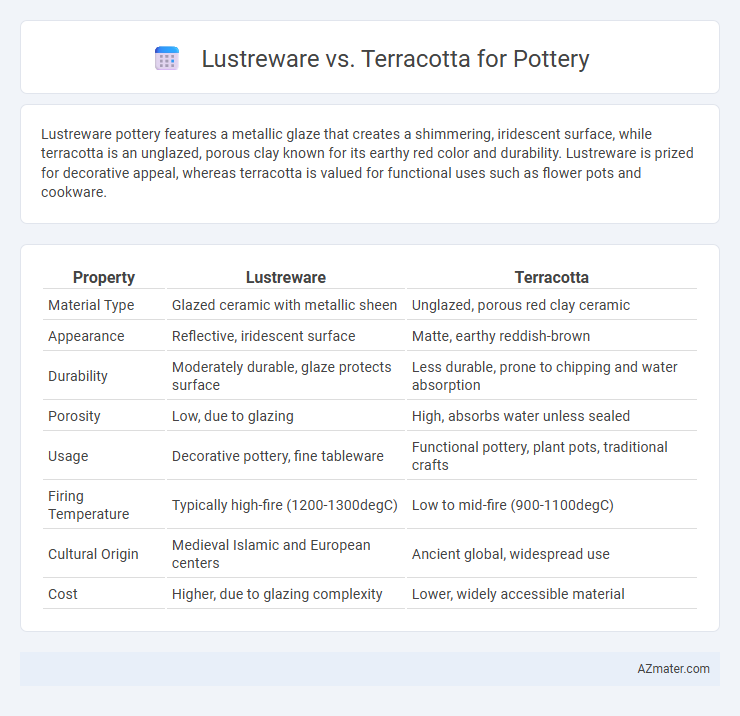Lustreware pottery features a metallic glaze that creates a shimmering, iridescent surface, while terracotta is an unglazed, porous clay known for its earthy red color and durability. Lustreware is prized for decorative appeal, whereas terracotta is valued for functional uses such as flower pots and cookware.
Table of Comparison
| Property | Lustreware | Terracotta |
|---|---|---|
| Material Type | Glazed ceramic with metallic sheen | Unglazed, porous red clay ceramic |
| Appearance | Reflective, iridescent surface | Matte, earthy reddish-brown |
| Durability | Moderately durable, glaze protects surface | Less durable, prone to chipping and water absorption |
| Porosity | Low, due to glazing | High, absorbs water unless sealed |
| Usage | Decorative pottery, fine tableware | Functional pottery, plant pots, traditional crafts |
| Firing Temperature | Typically high-fire (1200-1300degC) | Low to mid-fire (900-1100degC) |
| Cultural Origin | Medieval Islamic and European centers | Ancient global, widespread use |
| Cost | Higher, due to glazing complexity | Lower, widely accessible material |
Introduction to Lustreware and Terracotta
Lustreware is a type of pottery characterized by its iridescent metallic glaze, achieved through a complex firing process involving metal oxides, making it highly valued for decorative art. Terracotta, derived from natural clay, is a porous, unglazed ceramic known for its warm, earthy tones and durability, widely used in both functional and sculptural pottery. While lustreware emphasizes ornamental appeal through its shiny surface, terracotta offers rustic charm and versatility in traditional pottery-making.
Historical Background of Lustreware
Lustreware dates back to the 9th century during the Islamic Golden Age, renowned for its iridescent metallic glaze achieved through a complex firing process involving metal oxides and a second kiln firing. This technique spread across the Mediterranean, influencing European pottery styles, particularly in Italy and Spain during the Renaissance, where it was prized for its shimmering, metallic sheen. In contrast, terracotta, an ancient form of fired clay pottery, primarily features a porous, reddish-brown surface without the reflective qualities characteristic of lustreware.
Origins and Evolution of Terracotta
Terracotta pottery originated in ancient civilizations such as Mesopotamia and the Indus Valley, known for its porous, reddish-brown clay that is fired at low temperatures. Over centuries, terracotta evolved from simple utilitarian vessels to intricate sculptures and architectural elements, reflecting cultural and artistic advancements. Lustreware, by contrast, emerged much later in the medieval Islamic world, distinguished by its metallic glaze achieved through a complex firing process, thereby creating a glossy, iridescent surface unlike the matte finish typical of terracotta.
Material Composition and Properties
Lustreware pottery features a metallic glaze created by applying metallic oxides such as silver or copper, resulting in an iridescent finish achieved through reduction firing, which produces a thin layer of metal on the surface. Terracotta, made from natural clay fired at lower temperatures, is porous and unglazed, providing a matte, earthy texture that is highly breathable and ideal for plant pots and rustic pottery. While lustreware emphasizes decorative metallic sheen and fragility, terracotta is valued for durability, breathability, and natural clay composition.
Artistic Techniques and Glazing Differences
Lustreware pottery utilizes a metallic glaze that creates an iridescent sheen through the application of metal oxides and a reduction firing process, resulting in vibrant, shimmering surfaces. Terracotta, primarily unglazed or lightly glazed, features a porous, earthy red clay body that emphasizes texture and natural color rather than reflective qualities. The artistic technique of Lustreware demands intricate layering and precise firing to achieve its luminous effect, whereas Terracotta relies on handcrafting and simple glazing for rustic, matte finishes.
Durability and Functional Uses
Lustreware features a metallic glaze that provides a striking, iridescent finish but tends to be more delicate and prone to wear compared to terracotta. Terracotta is highly durable, made from fired clay with natural porosity, making it suitable for everyday functional uses like cooking and storing food. While lustreware is prized for decorative purposes, terracotta offers greater longevity and practical utility in pottery applications.
Visual Appeal and Color Palettes
Lustreware pottery is distinguished by its iridescent, metallic sheen that creates a captivating play of light, often featuring warm golds, coppers, and silvery hues. Terracotta pottery offers a more rustic and earthy visual appeal, typically showcasing natural reddish-brown, ochre, and muted tones that highlight its mineral-rich clay composition. Lustreware appeals to those seeking vibrant, reflective finishes, while Terracotta attracts enthusiasts of traditional, organic color palettes and textures.
Cultural Significance and Popularity
Lustreware pottery, renowned for its shimmering metallic glaze, holds strong cultural significance in Middle Eastern and Islamic art traditions, symbolizing luxury and craftsmanship. Terracotta pottery, with its earthy red and brown tones, reflects ancient and widespread cultural practices across many civilizations, often associated with everyday utility and ritualistic purposes. While Lustreware remains prized for decorative and ceremonial uses in art markets, Terracotta's enduring popularity stems from its versatility and deep historical roots in global pottery traditions.
Suitability for Modern Pottery Projects
Lustreware offers iridescent metallic glazes ideal for decorative, high-end modern pottery projects requiring a striking, reflective finish. Terracotta provides a natural, porous clay body suited for rustic, functional wares and outdoor ceramics that benefit from breathability and durability. Modern artisans often choose lustreware for aesthetic appeal in contemporary settings, while terracotta remains preferred for traditional, utilitarian designs.
Choosing Between Lustreware and Terracotta
Choosing between lustreware and terracotta pottery depends on the desired aesthetic and functional qualities. Lustreware features a shiny, iridescent glaze that enhances decorative appeal, while terracotta offers a porous, rustic texture suited for practical uses such as gardening or cooking. Consider factors like durability, usage environment, and artistic preference to decide which pottery type best fits your needs.

Infographic: Lustreware vs Terracotta for Pottery
 azmater.com
azmater.com